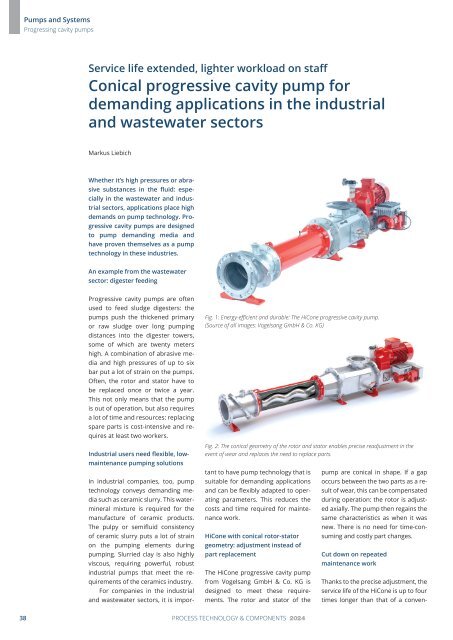PuK - Process Technology & Components 2024
A technical trade magazine with a history of more than 60 years.
A technical trade magazine with a history of more than 60 years.
You also want an ePaper? Increase the reach of your titles
YUMPU automatically turns print PDFs into web optimized ePapers that Google loves.
Pumps and Systems<br />
Progressing cavity pumps<br />
Service life extended, lighter workload on staff<br />
Conical progressive cavity pump for<br />
demanding applications in the industrial<br />
and wastewater sectors<br />
Markus Liebich<br />
Whether it’s high pressures or abrasive<br />
substances in the fluid: especially<br />
in the wastewater and industrial<br />
sectors, applications place high<br />
demands on pump technology. Progressive<br />
cavity pumps are designed<br />
to pump demanding media and<br />
have proven themselves as a pump<br />
technology in these industries.<br />
An example from the wastewater<br />
sector: digester feeding<br />
Progressive cavity pumps are often<br />
used to feed sludge digesters: the<br />
pumps push the thickened primary<br />
or raw sludge over long pumping<br />
distances into the digester towers,<br />
some of which are twenty meters<br />
high. A combination of abrasive media<br />
and high pressures of up to six<br />
bar put a lot of strain on the pumps.<br />
Often, the rotor and stator have to<br />
be replaced once or twice a year.<br />
This not only means that the pump<br />
is out of operation, but also requires<br />
a lot of time and resources: replacing<br />
spare parts is cost-intensive and requires<br />
at least two workers.<br />
Industrial users need flexible, lowmaintenance<br />
pumping solutions<br />
In industrial companies, too, pump<br />
technology conveys demanding media<br />
such as ceramic slurry. This watermineral<br />
mixture is required for the<br />
manufacture of ceramic products.<br />
The pulpy or semifluid consistency<br />
of ceramic slurry puts a lot of strain<br />
on the pumping elements during<br />
pumping. Slurried clay is also highly<br />
viscous, requiring powerful, robust<br />
industrial pumps that meet the requirements<br />
of the ceramics industry.<br />
For companies in the industrial<br />
and wastewater sectors, it is impor-<br />
Fig. 1: Energy-efficient and durable: The HiCone progressive cavity pump.<br />
(Source of all images: Vogelsang GmbH & Co. KG)<br />
Fig. 2: The conical geometry of the rotor and stator enables precise readjustment in the<br />
event of wear and replaces the need to replace parts.<br />
times longer than that of a conventant<br />
to have pump technology that is<br />
suitable for demanding applications<br />
and can be flexibly adapted to operating<br />
parameters. This reduces the<br />
costs and time required for maintenance<br />
work.<br />
HiCone with conical rotor-stator<br />
geometry: adjustment instead of<br />
part replacement<br />
The HiCone progressive cavity pump<br />
from Vogelsang GmbH & Co. KG is<br />
designed to meet these requirements.<br />
The rotor and stator of the<br />
pump are conical in shape. If a gap<br />
occurs between the two parts as a result<br />
of wear, this can be compensated<br />
during operation: the rotor is adjusted<br />
axially. The pump then regains the<br />
same characteristics as when it was<br />
new. There is no need for time-consuming<br />
and costly part changes.<br />
Cut down on repeated<br />
maintenance work<br />
Thanks to the precise adjustment, the<br />
service life of the HiCone is up to four<br />
38 PROCESS TECHNOLOGY & COMPONENTS <strong>2024</strong>

















